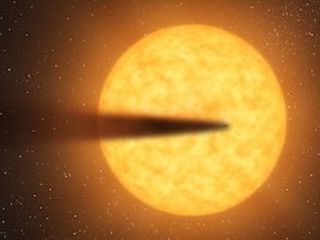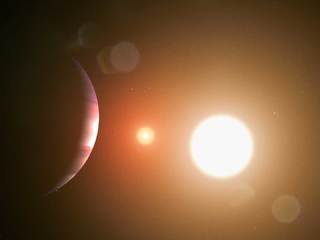News | March 23, 2020
Discovery Alert: New Planet — a Heavyweight, but Habitable?

Artist's rendering of a "super Earth," a planet larger than Earth but smaller than Neptune. A newly discovered star system includes three worlds in this size-range — one of them in the star's "habitable zone." Image credit: ESO/M. Kornmesser
The planet: GJ 1061d
The discovery: This planet joins a mysterious group — possibly habitable worlds in tight orbits around small, red-dwarf stars in our galaxy. GJ 1061d is part of a system of at least three planets a mere 12 light-years from Earth. Its surface temperature might be just right for liquid water.
Key facts: The planet is a bruiser, about 1.7 times the "weight," or mass, of Earth, and is probably a rocky world — imagine a scaled-up version of our planet. The energy it receives from its star is between what Earth and Mars receive from our Sun. In other words, the planet falls within its star’s “habitable zone.” If it is rocky and has a suitable atmosphere, GJ 1061d could have water on its surface.
Details: For now, that’s a very big “if.” On the plus side: The planet is the outermost of the three discovered in this system. That still places it in an extremely tight orbit — a “year” on this world, once around the star, takes only 12 to 13 days. But because its red-dwarf star is so small and cool, the closer orbit still means a potentially temperate planet. Another plus: the star seems to be older, and less active than young red dwarfs, so the planet could be less prone to sterilizing stellar flares. On the minus side: We don’t know some of the basic properties of GJ 1061d, such as how big around it is, its true composition or whether it has any atmosphere at all. All this will require future investigation.
Fun facts: The discovery of this new planetary system, whose other two planets also outweigh Earth, is part of an unusual scientific campaign called the “Red Dots” collaboration. Carl Sagan famously called our planet a “pale blue dot;” the red dots are the red dwarf stars within 16 light-years of Earth. The Red Dots approach — zeroing in on one star at a time — has yielded other exciting discoveries, including that of a potentially rocky planet orbiting our nearest stellar neighbor, Proxima Centauri. Some 15 exoplanet systems are known within 16 light-years, most of them around red dwarfs, also called M-type stars. Together, these systems possess 33 planets; more than half include more than one planet. And the new system resembles other, more distant systems, including the seven roughly Earth-sized planets orbiting a red dwarf, TRAPPIST-1, some 40 light-years away.
The discoverers: An international team led by Stefan Dreizler of the University of Gottingen, in Germany, discovered the new system using an instrument called the HARPS spectrograph on the 3.6-meter European Southern Observatory telescope at La Silla, Chile. The instrument measures "wobbles" in the motion of a star, caused by the gravitational tugs of orbiting planets — a method of exoplanet detection known as "radial velocity." The three new planets were among nine entered into NASA's Exoplanet Archive on March 5, 2020.
Read the paper











